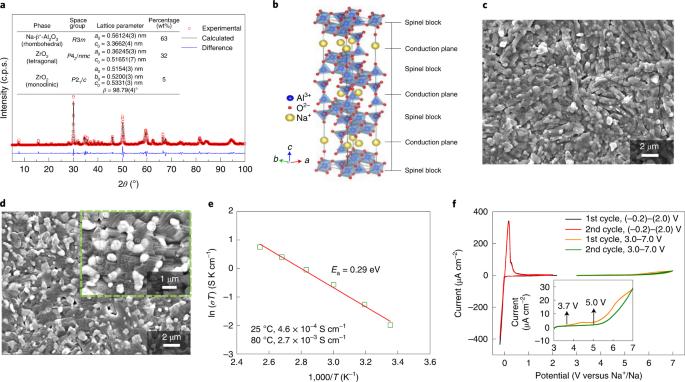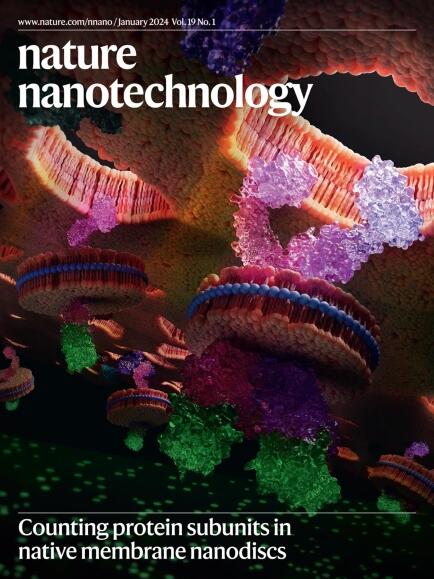Interfacial-engineering-enabled practical low-temperature sodium metal battery
IF 34.9
1区 材料科学
Q1 MATERIALS SCIENCE, MULTIDISCIPLINARY
引用次数: 31
Abstract
Solid-state sodium (Na) batteries have received extensive attention as a promising alternative to room-temperature liquid electrolyte Na-ion batteries and high-temperature liquid electrode Na–S batteries because of safety concerns. However, the major issues for solid-state Na batteries are a high interfacial resistance between solid electrolytes and electrodes, and Na dendrite growth. Here we report that a yttria-stabilized zirconia (YSZ)-enhanced beta-alumina solid electrolyte (YSZ@BASE) has an extremely low interface impedance of 3.6 Ω cm2 with the Na metal anode at 80 °C, and also exhibits an extremely high critical current density of ~7.0 mA cm–2 compared with those of other Li- and Na-ion solid electrolytes reported so far. With a trace amount of eutectic NaFSI–KFSI molten salt at the electrolyte/cathode interface, a quasi-solid-state Na/YSZ@BASE/NaNi0.45Cu0.05Mn0.4Ti0.1O2 full cell achieves a high capacity of 110 mAh g–1 with a Coulombic efficiency >99.99% and retains 73% of the cell capacity over 500 cycles at 4C and 80 °C. Extensive characterizations and theoretical calculations prove that the stable β-NaAlO2-rich solid–electrolyte interphase and strong YSZ support matrix play a critical role in suppressing the Na dendrite as they maintain robust interfacial contacts, lower electronic conduction and prevent the continual reduction of BASE through oxygen-ion compensation. Beta-alumina solid electrolyte enhanced by yttria-stabilized zirconia can provide a very low interfacial impedance with a sodium metal anode and a critical current density higher than those previously reported in lithium and sodium batteries.

通过界面工程实现实用低温钠金属电池
由于安全问题,固态钠(Na)电池作为室温液态电解质钠离子电池和高温液态电极 Na-S 电池的理想替代品受到广泛关注。然而,固态 Na 电池的主要问题是固态电解质和电极之间的高界面电阻以及 Na 树枝状晶体生长。在此,我们报告了一种钇稳定氧化锆(YSZ)增强型β-氧化铝固体电解质(YSZ@BASE),与 Na 金属阳极在 80 °C 时的界面阻抗极低,仅为 3.6 Ω cm2,而且与迄今报道的其他锂离子和 Na 离子固体电解质相比,临界电流密度极高,约为 7.0 mA cm-2。在电解质/阴极界面上加入微量共晶 NaFSI-KFSI 熔盐后,准固态 Na/YSZ@BASE/NaNi0.45Cu0.05Mn0.4Ti0.1O2 全电池的容量达到 110 mAh g-1,库仑效率为 99.99%,并且在 4C 和 80 °C 下循环 500 次后电池容量仍能保持 73%。广泛的表征和理论计算证明,稳定的富含 β-NaAlO2 的固态电解质相间和强大的 YSZ 支撑基质在抑制 Na 树枝状突起方面发挥了关键作用,因为它们能保持稳固的界面接触,降低电子传导,并防止 BASE 通过氧离子补偿继续还原。由钇稳定氧化锆增强的β-氧化铝固态电解质可提供与钠金属阳极之间极低的界面阻抗,临界电流密度也高于之前报道的锂电池和钠电池的临界电流密度。
本文章由计算机程序翻译,如有差异,请以英文原文为准。
求助全文
约1分钟内获得全文
求助全文
来源期刊

Nature nanotechnology
工程技术-材料科学:综合
CiteScore
59.70
自引率
0.80%
发文量
196
审稿时长
4-8 weeks
期刊介绍:
Nature Nanotechnology is a prestigious journal that publishes high-quality papers in various areas of nanoscience and nanotechnology. The journal focuses on the design, characterization, and production of structures, devices, and systems that manipulate and control materials at atomic, molecular, and macromolecular scales. It encompasses both bottom-up and top-down approaches, as well as their combinations.
Furthermore, Nature Nanotechnology fosters the exchange of ideas among researchers from diverse disciplines such as chemistry, physics, material science, biomedical research, engineering, and more. It promotes collaboration at the forefront of this multidisciplinary field. The journal covers a wide range of topics, from fundamental research in physics, chemistry, and biology, including computational work and simulations, to the development of innovative devices and technologies for various industrial sectors such as information technology, medicine, manufacturing, high-performance materials, energy, and environmental technologies. It includes coverage of organic, inorganic, and hybrid materials.
 求助内容:
求助内容: 应助结果提醒方式:
应助结果提醒方式:


